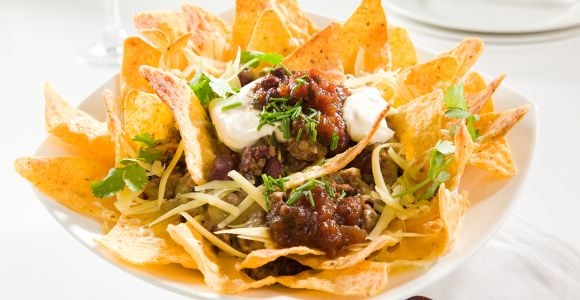With football season in full swing and loads of snack foods to munch on, it's easy to lose track of healthy eating. While there are lots of different snack foods to choose, nachos are an American favorite. It's difficult to pass up the warm, cheesy, crunchy sensation that taste so good but yet provides no nutritional value. And let's be honest; who can eat just a few? But nachos don't have to be a nutritional enemy. With a few quick and easy changes, nachos can be loaded with beneficial nutrients including protein, fiber, calcium, and iron.
Let's take a look how you can prepare nachos without feeling guilty!
Chips
The base of any nacho recipe is the chips. Instead of using regular white flour or corn-based tortilla chips choose whole grain products. Make sure to read the ingredient list on the package: wheat does not always mean whole grain. Double check the ingredient list and look for "whole" grain or "whole" wheat as one of the first two ingredients. If you can't find a whole grain chip, they are easy to make at home. Start by preheating the oven to 500°F and run cold water quickly over whole grain tortillas. Stack tortillas and cut into chip sized wedges and spread over a baking sheet. Bake for 5 minutes, turn and bake for 2 to 3 more minutes.
Cheese and Sour Cream
While cheese is a good source of protein, it also can contains large amounts of saturated and trans fat. Start by reducing the cheese used on the nachos by 25%. Also avoid using pre-made cheese sauce and stick with non-processed cheeses naturally lower in fat such as part-skim mozzarella or any reduced fat cheddar or American. Low fat cheeses have similar calcium and protein amounts thus you can reduce calories while still keeping the beneficial nutrients. Sour cream is available in low fat or fat free versions which will save you 20 and 40 calories per 2 tablespoon serving respectively.
Meat
Whether you choose turkey, chicken or beef, aim for the leanest source you can find. Most meat and poultry products can be found as low as 97% fat free. For a healthy vegetarian protein source, try using soy crumbles found in the frozen food section or tofu. For extra flavor with no added calories, mix the nacho meat with garlic powder, onion powder, cayenne pepper, cumin and chili powder.
Beans
The key to making your nacho dish a fiber powerhouse is the addition of beans. Luckily, a variety of beans work with nachos including black beans, garbanzo beans and fat free refried beans.
Vegetables
The different types and colors of vegetables that can be added to nachos are endless. More vegetables mean more fiber, vitamins, minerals and less calories and fat. Of course include the typical tomatoes, but also try bell peppers, jalapenos, zucchini, green onions and eggplant. Make sure each chip is loaded with these healthy additions.
Healthy options are endless with nachos! Try adding flaxseed mill, which is high in omega-3 fatty acids and fiber, to the meat or salsa portion or just as a topping. Overall limit the high fat toppings such as guacamole, sour cream and cheese. It only takes a small amount of these products to get a strong and tasty flavor. With some low-fat substitutions and the addition of healthy beans and vegetables, nachos can fit into almost any diet.
Laura N. Kenny is a Registered Dietitian and Certified Dietitian in the state of Indiana. She received both her Bachelor of Science degree in Dietetics and completed her dietetic internship at Purdue University. She is currently pursuing her Master of Science degree from Central Michigan University. Laura works for the Indiana Obesity Center PC under the supervision of Dr. Keith McEwen. She specializes in both surgical and non-surgical weight loss including nutritional adherence, meal planning, and macro/micro nutrient status. Kenny also promotes healthy eating through various speaking engagements throughout Indianapolis and teaches indoor cycling and Pilates classes in her free time. Since staring her dietetics career, she has worked with a variety of populations and chronic diseases. Each summer Laura volunteers at Camp John Warvel, a camp for children with diabetes. She also enjoys writing, sports, exercise, and reading "hot topics" in nutrition. Laura has a true passion for guiding people to choose healthy nutritional choices for each and every individual lifestyle. To contact Laura, email her at [email protected]. She can be reached via email at at [email protected].



